engine TOYOTA HILUX 2020 Owners Manual (in English)
[x] Cancel search | Manufacturer: TOYOTA, Model Year: 2020, Model line: HILUX, Model: TOYOTA HILUX 2020Pages: 744, PDF Size: 108.13 MB
Page 629 of 744

6298-2. Steps to take in an emergency
HILUX_OM_OM0K321E_(EE)
8
When trouble arises
If a tow truck is not available in an emergency, your vehicle may be
temporarily towed using cables or chains secured to the emergency
towing hooks. This should only be attempted on hard surfaced roads
for at most 80 km (50 miles) at under 30 km/h (18 mph).
A driver must be in the vehicle to steer and operate the brakes. The
vehicle’s wheels, drive train, axles, steering and brakes must be in
good condition.
Securely attach cables or
chains to the towing hooks.
Take care not to damage the vehi-
cle body.
Enter the vehicle being towed and start the engine.
If the engine does not start, turn the engine switch to the “ON” position
(vehicles without smart entry & start system) or IGNITION ON mode (vehi-
cles with smart entry & start system).
Vehicles with Stop & Start system:
Before towing the vehicle, turn the engine switch to the “LOCK” position
(vehicles without smart entry & start system) or off (vehicles with smart
entry & start system) once, and then start the engine.
4WD models: Turn the front-wheel drive control switch to H2.
( P. 398)
Shift the shift lever to N and release the parking brake.
When the shift lever cannot be shifted (automatic transmission):
P. 2 9 8
Emergency towing
Emergency towing procedure
1
2
3
4
Page 630 of 744

6308-2. Steps to take in an emergency
HILUX_OM_OM0K321E_(EE)
■While towing
If the engine is not running, the power assist for the brakes and steering will
not function, making steering and braking more difficult.
WARNING
Observe the following precautions.
Failure to do so may result in death or serious injury.
■ When towing the vehicle
■ While towing
● When towing using cables or chains, avoid sudden starts, etc. which place
excessive stress on the towing hooks, cables or chains. The towing hooks,
cables or chains may become damaged, broken debris may hit people,
and cause serious damage.
● Do not turn the engine switch to the “LOCK” position (vehicles without
smart entry & start system) or off (vehicles with smart entry & start sys-
tem).
There is a possibility that the steering wheel is locked and cannot be oper-
ated.
Pre Runner (2WD models): Be sure to
transport the vehicle with all four wheels
raised off the ground. If the vehicle is
towed with the tires contacting the
ground, the drivetrain and related parts
may be damaged or an accident may
occur due to a change in direction of the
vehicle.
4WD models: Be sure to transport the
vehicle with all four wheels raised off the
ground. If the vehicle is towed with the
tires contacting the ground, the drivetrain
and related parts may be damaged, and
the vehicle may fly off the truck.
Page 631 of 744
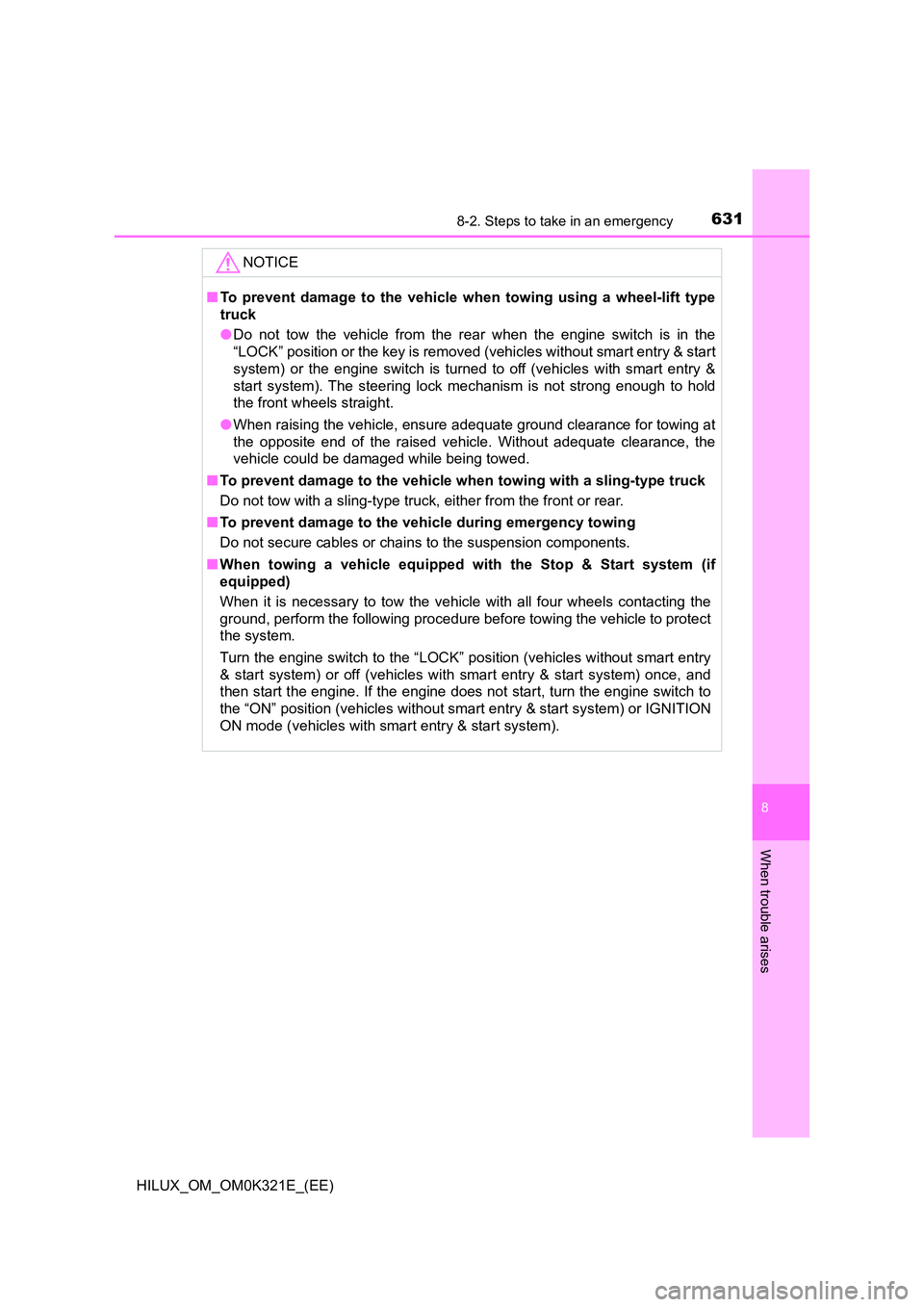
6318-2. Steps to take in an emergency
HILUX_OM_OM0K321E_(EE)
8
When trouble arises
NOTICE
■To prevent damage to the vehicle when towing using a wheel-lift type
truck
● Do not tow the vehicle from the rear when the engine switch is in the
“LOCK” position or the key is removed (vehicles without smart entry & start
system) or the engine switch is turned to off (vehicles with smart entry &
start system). The steering lock mechanism is not strong enough to hold
the front wheels straight.
● When raising the vehicle, ensure adequate ground clearance for towing at
the opposite end of the raised vehicle. Without adequate clearance, the
vehicle could be damaged while being towed.
■ To prevent damage to the vehicle when towing with a sling-type truck
Do not tow with a sling-type truck, either from the front or rear.
■ To prevent damage to the vehicle during emergency towing
Do not secure cables or chains to the suspension components.
■ When towing a vehicle equipped with the Stop & Start system (if
equipped)
When it is necessary to tow the vehicle with all four wheels contacting the
ground, perform the following procedure before towing the vehicle to protect
the system.
Turn the engine switch to the “LOCK” position (vehicles without smart entry
& start system) or off (vehicles with smart entry & start system) once, and
then start the engine. If the engine does not start, turn the engine switch to
the “ON” position (vehicles without smart entry & start system) or IGNITION
ON mode (vehicles with smart entry & start system).
Page 632 of 744
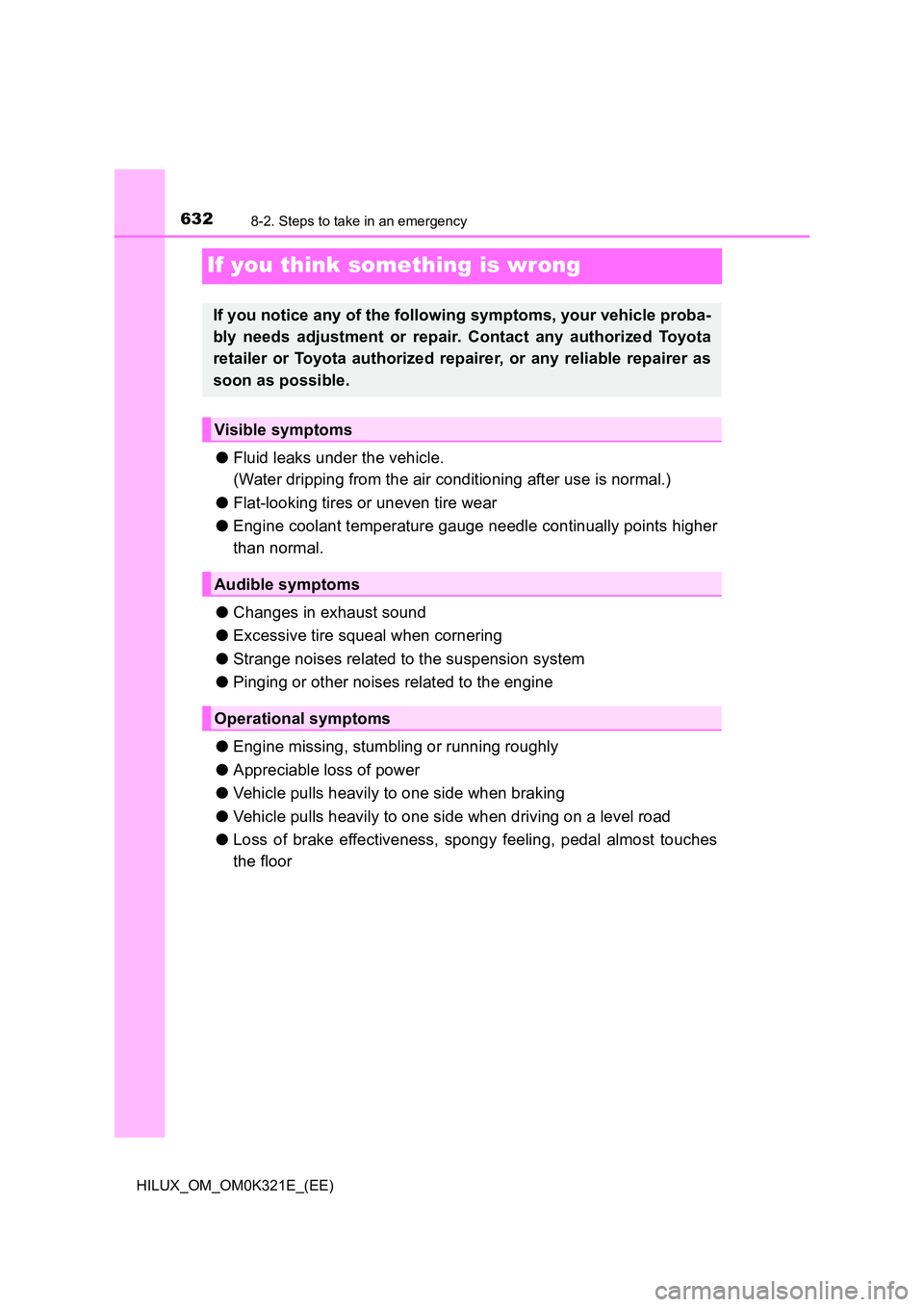
6328-2. Steps to take in an emergency
HILUX_OM_OM0K321E_(EE)
If you think something is wrong
●Fluid leaks under the vehicle.
(Water dripping from the air conditioning after use is normal.)
● Flat-looking tires or uneven tire wear
● Engine coolant temperature gauge needle continually points higher
than normal.
● Changes in exhaust sound
● Excessive tire squeal when cornering
● Strange noises related to the suspension system
● Pinging or other noises related to the engine
● Engine missing, stumbling or running roughly
● Appreciable loss of power
● Vehicle pulls heavily to one side when braking
● Vehicle pulls heavily to one side when driving on a level road
● Loss of brake effectiveness, spongy feeling, pedal almost touches
the floor
If you notice any of the following symptoms, your vehicle proba-
bly needs adjustment or repair. Contact any authorized Toyota
retailer or Toyota authorized repairer, or any reliable repairer as
soon as possible.
Visible symptoms
Audible symptoms
Operational symptoms
Page 633 of 744

6338-2. Steps to take in an emergency
HILUX_OM_OM0K321E_(EE)
8
When trouble arises
Fuel pump shut off system (gasoline engine only)
Follow the procedure below to restart the engine after the system is
activated.
Turn the engine switch to the “ACC” or “LOCK” position (vehicles
without smart entry & start system) or ACCESSORY mode or off
(vehicles with smart entry & start system).
Restart the engine.
To minimize the risk of fuel leakage when the engine stalls or
when an airbag inflates upon collision, the fuel pump shut off
system stops the supply of fuel to the engine.
NOTICE
■ Before starting the engine
Inspect the ground under the vehicle.
If you find that fuel has leaked onto the ground, the fuel system has been
damaged and is in need of repair. Do not restart the engine.
1
2
Page 634 of 744

6348-2. Steps to take in an emergency
HILUX_OM_OM0K321E_(EE)
If a warning light turns on or a warning
buzzer sounds
Calmly perform the following actions if any of the warning lights
comes on or flashes. If a light comes on or flashes, but then
goes off, this does not necessarily indicate a malfunction in the
system. However, if this continues to occur, have the vehicle
inspected by any authorized Toyota retailer or Toyota authorized
repairer, or any reliable repairer.
Warning light and warning buzzer list
Warning lightWarning light/Details/Actions
Brake system warning light (warning buzzer)
Indicates:
• Low brake fluid
• Malfunction in the brake system
• Low negative pressure in the vacuum tank (diesel
engine)
Immediately stop the vehicle in a safe place and con-
tact any authorized Toyota retailer or Toyota autho-
rized repairer, or any reliable repairer. Continuing to
drive the vehicle may be dangerous.
Charging system warning light (if equipped)
Indicates a malfunction in the vehicle’s charging system
Immediately stop the vehicle in a safe place and con-
tact any authorized Toyota retailer or Toyota autho-
rized repairer, or any reliable repairer.
Low engine oil pressure warning light (warning buzzer)
(if equipped) *1
Indicates that the engine oil pressure is too low (This
warning light may come on if the vehicle is stopped on a
slope. Move to a level surface and check to see if the light
goes off.)
Immediately stop the vehicle in a safe place and con-
tact any authorized Toyota retailer or Toyota autho-
rized repairer, or any reliable repairer.
Page 635 of 744
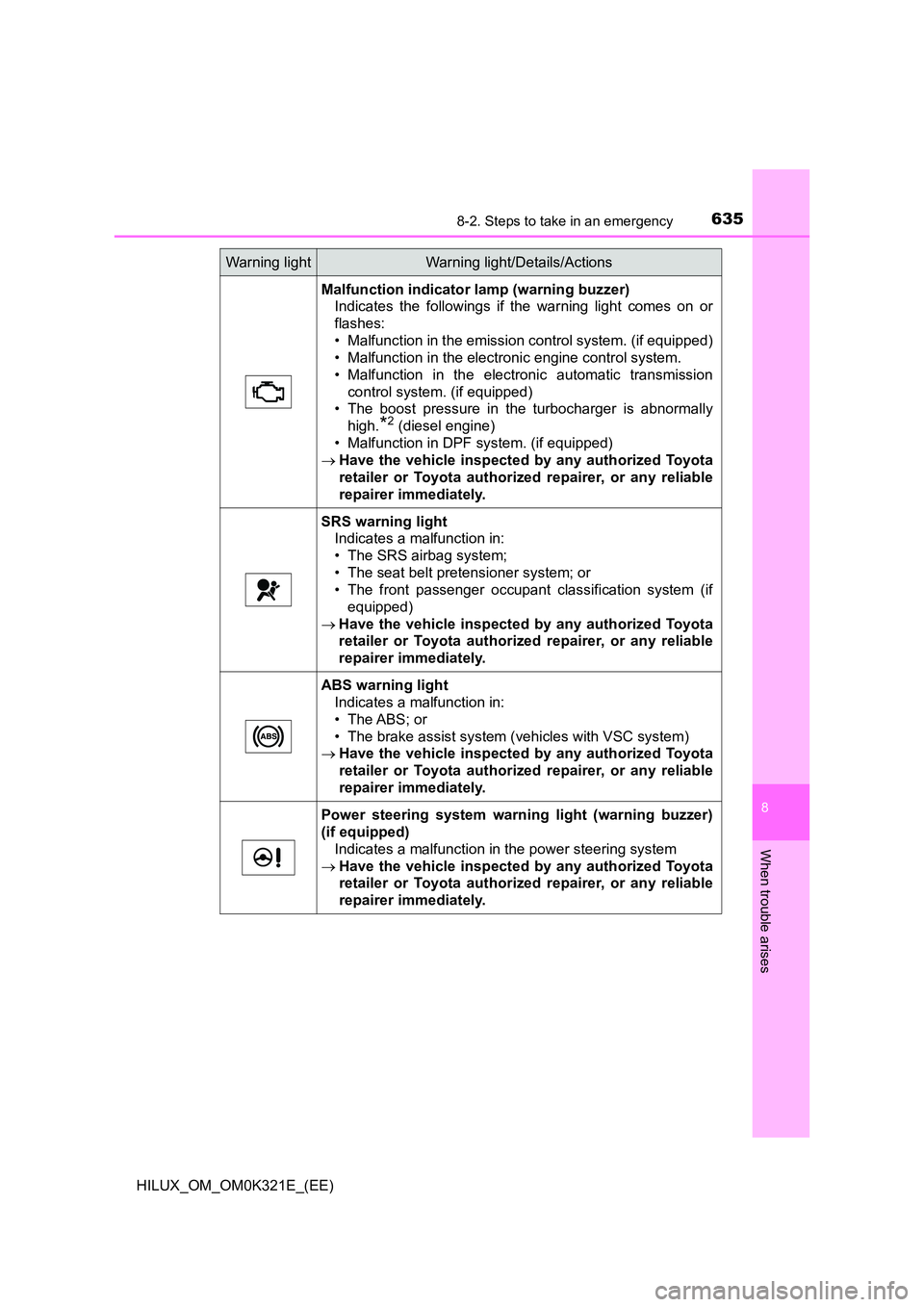
6358-2. Steps to take in an emergency
HILUX_OM_OM0K321E_(EE)
8
When trouble arises
Malfunction indicator lamp (warning buzzer)
Indicates the followings if the warning light comes on or
flashes:
• Malfunction in the emission control system. (if equipped)
• Malfunction in the electronic engine control system.
• Malfunction in the electronic automatic transmission
control system. (if equipped)
• The boost pressure in the turbocharger is abnormally
high.*2 (diesel engine)
• Malfunction in DPF system. (if equipped)
Have the vehicle inspected by any authorized Toyota
retailer or Toyota authorized repairer, or any reliable
repairer immediately.
SRS warning light
Indicates a malfunction in:
• The SRS airbag system;
• The seat belt pretensioner system; or
• The front passenger occupant classification system (if
equipped)
Have the vehicle inspected by any authorized Toyota
retailer or Toyota authorized repairer, or any reliable
repairer immediately.
ABS warning light
Indicates a malfunction in:
• The ABS; or
• The brake assist system (vehicles with VSC system)
Have the vehicle inspected by any authorized Toyota
retailer or Toyota authorized repairer, or any reliable
repairer immediately.
Power steering system warning light (warning buzzer)
(if equipped)
Indicates a malfunction in the power steering system
Have the vehicle inspected by any authorized Toyota
retailer or Toyota authorized repairer, or any reliable
repairer immediately.
Warning lightWarning light/Details/Actions
Page 639 of 744
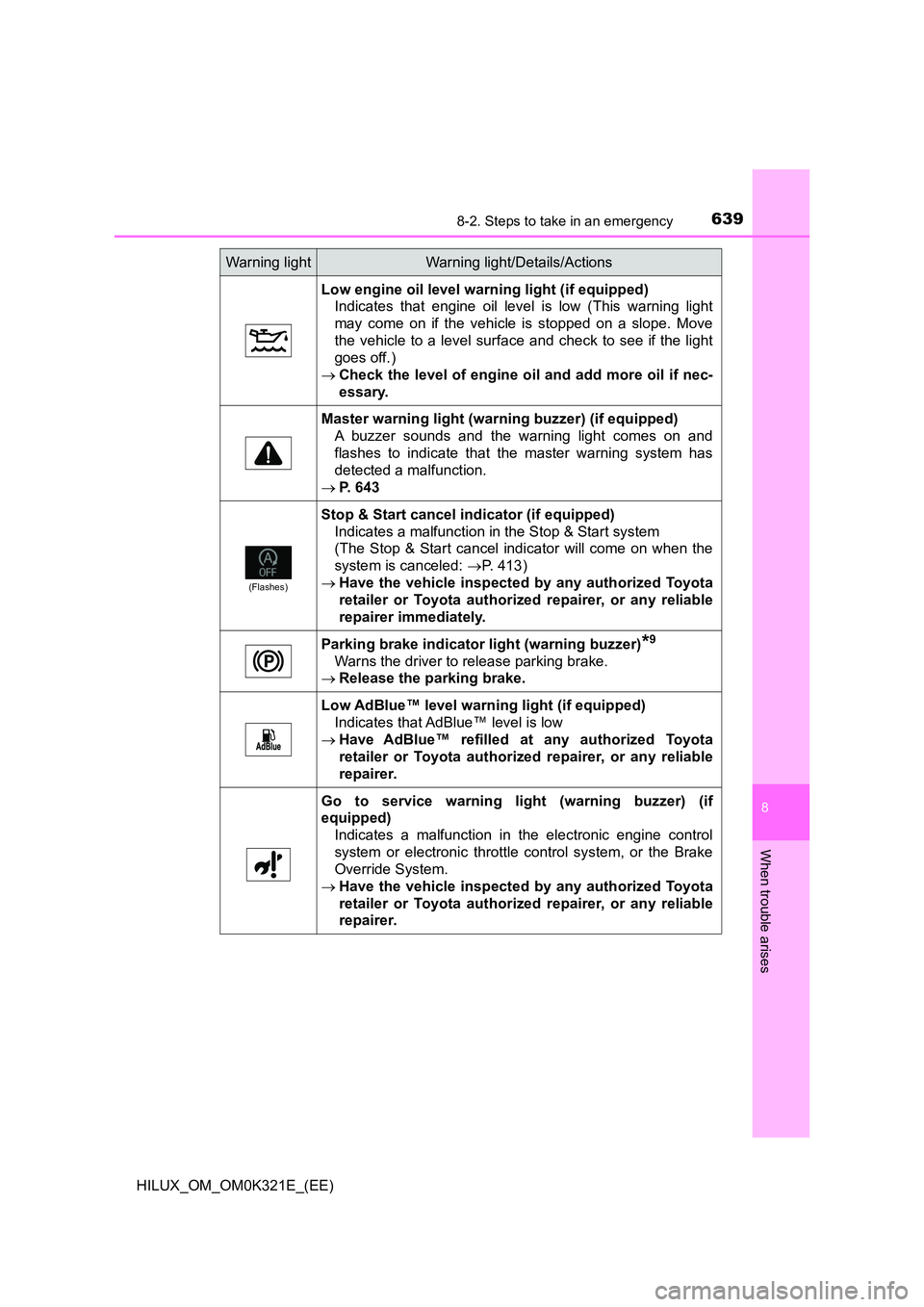
6398-2. Steps to take in an emergency
HILUX_OM_OM0K321E_(EE)
8
When trouble arises
Low engine oil level warning light (if equipped)
Indicates that engine oil level is low (This warning light
may come on if the vehicle is stopped on a slope. Move
the vehicle to a level surface and check to see if the light
goes off.)
Check the level of engine oil and add more oil if nec-
essary.
Master warning light (warning buzzer) (if equipped)
A buzzer sounds and the warning light comes on and
flashes to indicate that the master warning system has
detected a malfunction.
P. 643
(Flashes)
Stop & Start cancel indicator (if equipped)
Indicates a malfunction in the Stop & Start system
(The Stop & Start cancel indicator will come on when the
system is canceled: P. 413)
Have the vehicle inspected by any authorized Toyota
retailer or Toyota authorized repairer, or any reliable
repairer immediately.
Parking brake indicator light (warning buzzer)*9
Warns the driver to release parking brake.
Release the parking brake.
Low AdBlue™ level warning light (if equipped)
Indicates that AdBlue™ level is low
Have AdBlue™ refilled at any authorized Toyota
retailer or Toyota authorized repairer, or any reliable
repairer.
Go to service warning light (warning buzzer) (if
equipped)
Indicates a malfunction in the electronic engine control
system or electronic throttle control system, or the Brake
Override System.
Have the vehicle inspected by any authorized Toyota
retailer or Toyota authorized repairer, or any reliable
repairer.
Warning lightWarning light/Details/Actions
Page 642 of 744
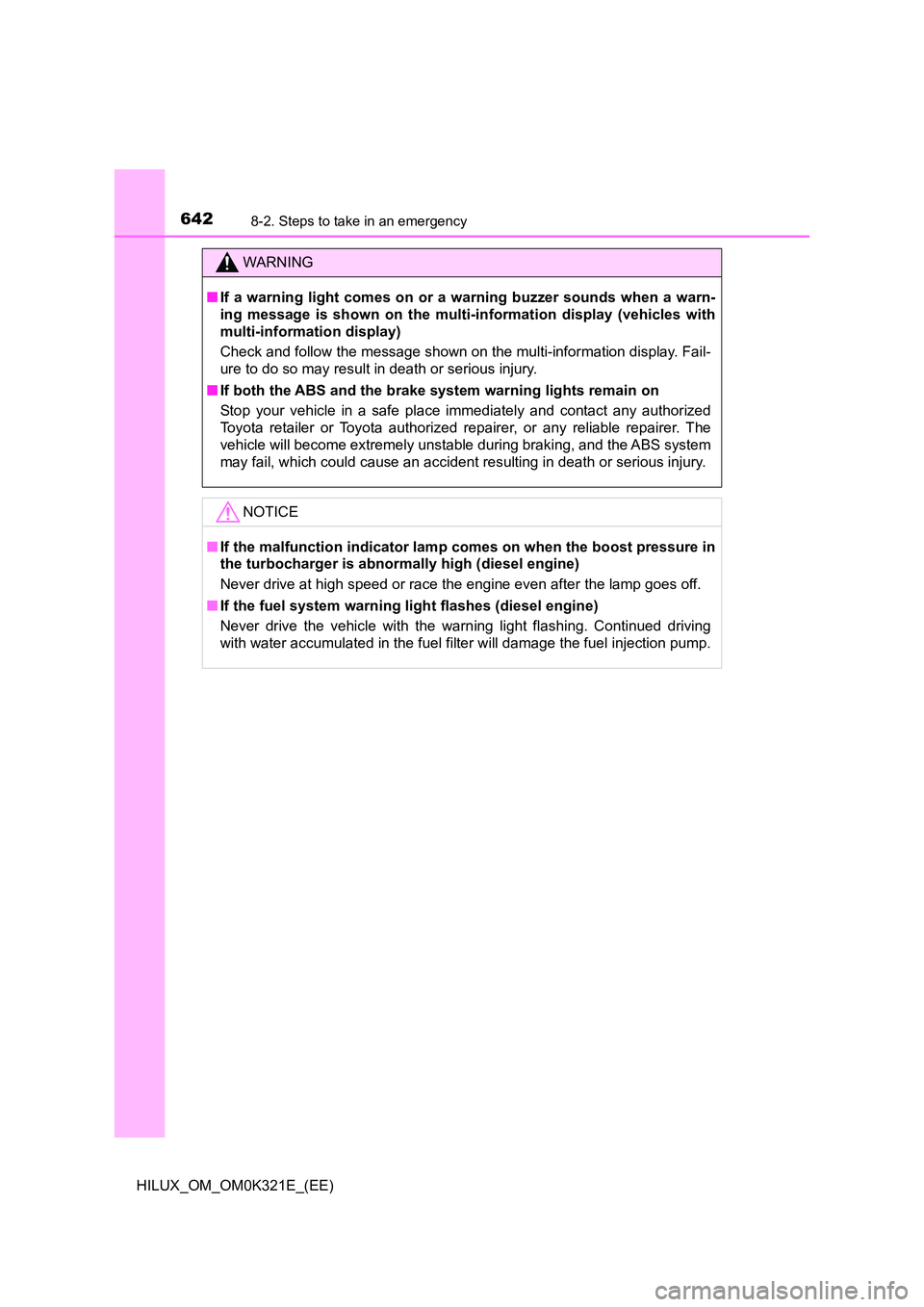
6428-2. Steps to take in an emergency
HILUX_OM_OM0K321E_(EE)
WARNING
■If a warning light comes on or a warning buzzer sounds when a warn-
ing message is shown on the multi-information display (vehicles with
multi-information display)
Check and follow the message shown on the multi-information display. Fail-
ure to do so may result in death or serious injury.
■ If both the ABS and the brake system warning lights remain on
Stop your vehicle in a safe place immediately and contact any authorized
Toyota retailer or Toyota authorized r epairer, or any reliable repairer. The
vehicle will become extremely unstable during braking, and the ABS system
may fail, which could cause an accident resulting in death or serious injury.
NOTICE
■ If the malfunction indicator lamp comes on when the boost pressure in
the turbocharger is abnormally high (diesel engine)
Never drive at high speed or race the engine even after the lamp goes off.
■ If the fuel system warning light flashes (diesel engine)
Never drive the vehicle with the warn ing light flashing. Continued driving
with water accumulated in the fuel filter will damage the fuel injection pump.
Page 645 of 744

6458-2. Steps to take in an emergency
HILUX_OM_OM0K321E_(EE)
8
When trouble arises
■Warning messages
The warning messages explained below may differ from the actual messages
according to operation conditions and vehicle specifications.
■ If is shown on the multi-information display
The engine oil pressure is too low. (This warning message may be displayed
if the vehicle is stopped on a slope. Move to a level surface and check to see
if the message goes off.)
Immediately stop the vehicle in a safe place and contact any authorized
Toyota retailer or Toyota authorized repai rer, or any reliable repairer. Continu-
ing to drive the vehicle may be dangerous.
■ If “ACCELERATOR AND BRAKE PEDALS DEPRESSED SIMULTANE-
OUSLY”/“Accelerator and brake pedals depressed simultaneously” is
shown on the multi-information display
The accelerator and brake pedal are being depressed simultaneously.
( P. 257)
Release the accelerator pedal and depress the brake pedal.
■ If “WINDSHIELD WASHER FLUID LOW”/“Windshield washer fluid low” is
shown on the multi-information display
The washer fluid level is low.
Add washer fluid. ( P. 5 8 2 )
■ If “OIL MAINTENANCE REQUIRED SOON”/“Oil maintenance required
soon” is shown on the multi-information display
The engine oil is scheduled to be changed.
Check the engine oil, and change if necessary. After changing the engine oil,
the oil change system should be reset. ( P. 575)
For Russia, Ukraine, Byelarus, Moldova, Bosnia Herzegovina, Montenegro,
Serbia and Macedonia: You have forgotten to reset the oil change system.
Change the engine oil in accordance with the maintenance schedule.
■ If “OIL MAINTENANCE REQUIRED”/“Oil maintenance required” is
shown on the multi-information display
The engine oil is scheduled to be changed.
Check and change the engine oil, and oil filter by any authorized Toyota
retailer or Toyota authorized repairer, or any reliable repairer. After changing
the engine oil, the oil change system should be reset. ( P. 575)
For Russia, Ukraine, Byelarus, Moldova, Bosnia Herzegovina, Montenegro,
Serbia and Macedonia: You have forgotten to reset the oil change system.
Change the engine oil in accordance with the maintenance schedule.